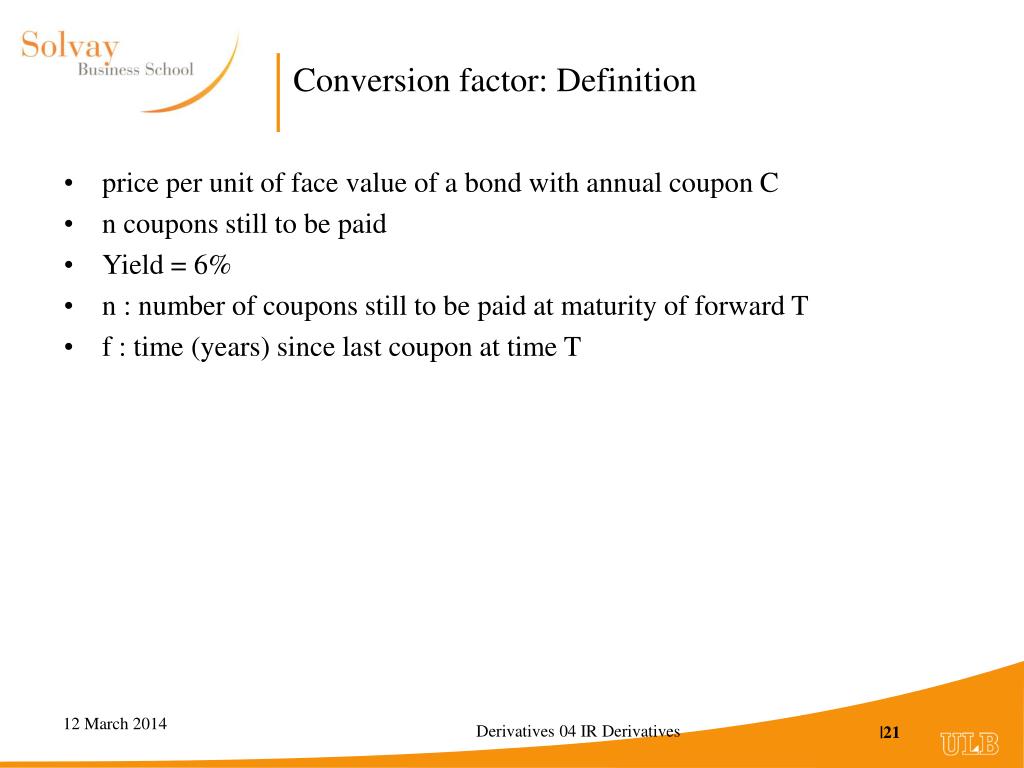Every cash note or bond that is eligible for delivery into a Treasury futures contract has a conversion factor that reflects its coupon and remaining time to maturity as of a specific delivery month. A conversion factor is the approximate decimal price at which $1 par of a security would trade if it had a 6% yield-to-maturity. Rentzler, Trading treasury bond spreads against treasury bill futures—a model and empirical test of the turtle trade, Journal of Futures Markets, 10.1002/fut., 6, 1, (41-61), (2006).
Reference dates for which conversion factor is computed (usually the first day of delivery months), specified as an N-by-1 vector of serial date numbers.
Data Types: double

Maturity date, specified as a N-by-1 vector of serial date numbers.
A bond is a type of loan contract between an issuer (the seller of the bond) and a holder (the purchaser of a bond). The issuer is essentially borrowing or incurring a debt that is to be repaid at. Bond Futures, Conversion Factor and Cheapest-to-deliver (CTD) Definition A bond futures contract is an agreement on a recognised futures exchange to buy or sell a standard face-value amount of a bond, at an agreed price, for settlement on a standard future delivery date. About CME Group. As the world's leading and most diverse derivatives marketplace, CME Group is where the world comes to manage risk. Comprised of four exchanges - CME, CBOT, NYMEX and COMEX - we offer the widest range of global benchmark products across all major asset classes, helping businesses everywhere mitigate the myriad of risks they face in today's uncertain global economy.
Data Types: double
CouponRate — Annual coupon rates for underlying bond
vector in decimals
Annual coupon rates for underlying bond, specified as an numBonds-by-1 vector in decimals.
Data Types: double
Name-Value Pair Arguments
Specify optional comma-separated pairs of Name,Value arguments. Name is the argument name and Value is the corresponding value. Name must appear inside quotes. You can specify several name and value pair arguments in any order as Name1,Value1,..,NameN,ValueN.
CF = convfactor(RefDate,Maturity,CouponRate,'Convention',2)'Convention' — Conversion factor convention
1 US Treasury bond (30-year) and Treasury note (10-year) futures contract (default) | integer from 1 to 5
Conversion factor convention, specified as the comma-separated pair consisting of 'Convention' and a N-by-1 vector using the following values: Solving math word problems free.
1= US Treasury bond (30-year) and Treasury note (10-year) futures contract2= US 2-year and 5-year Treasury note futures contract3= German Bobl, Bund, Buxl, and Schatz4= UK gilts5= Japanese Government Bonds (JGBs)
Data Types: double
'FirstCouponDate' — Irregular first coupon date
serial date number
Irregular first coupon date, specified as the comma-separated pair consisting of 'FirstCouponDate' and a N-by-1 vector using a serial date numbers.
Data Types: double
'RefYield' — Reference semiannual yield
0.06 (6%) (default) | vector in decimals
Reference semiannual yield, specified as the comma-separated pair consisting of 'RefYield' and an N-by-1 vector in decimals.
Data Types: double
'StartDate' — Forward starting date of payments
serial date number
Unit Factor Label
Forward starting date of payments, specified as the comma-separated pair consisting of 'StartDate' and a N-by-1 vector using serial date numbers.
Download Bond Conversion Factor Formula Backstage Present Value
Data Types: double
